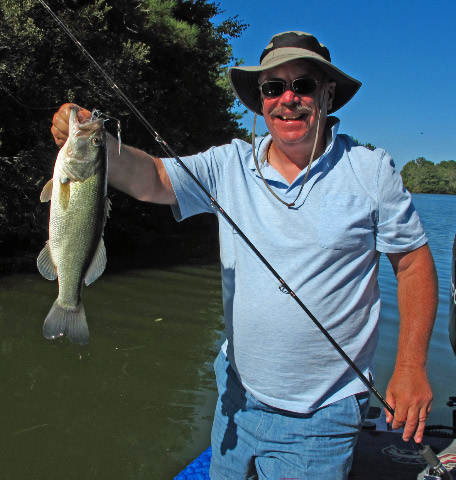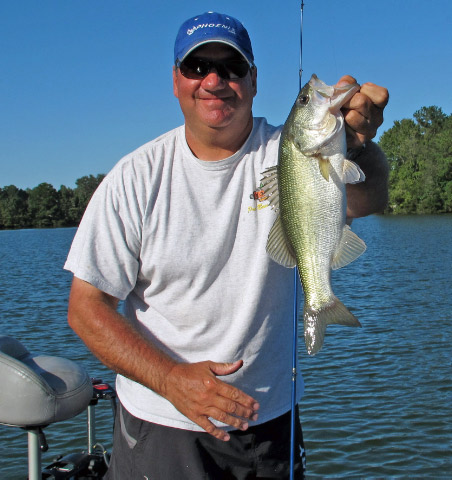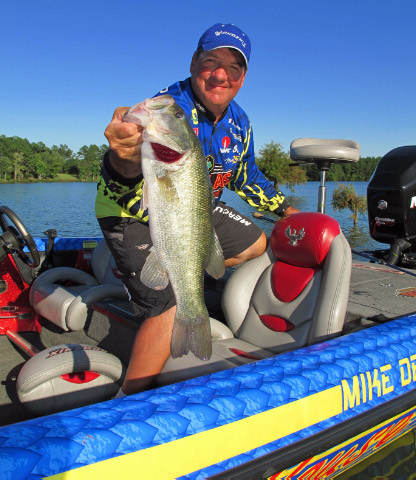Texas Roadhouse pro-staffer Mike DelVisco invited me to visit the trophy bass lakes managed by Marc Deschenes, owner of V.I.P. Adventures, a bass fishing wonderland on a park-like private property in Summerville outside Charleston, South Carolina.
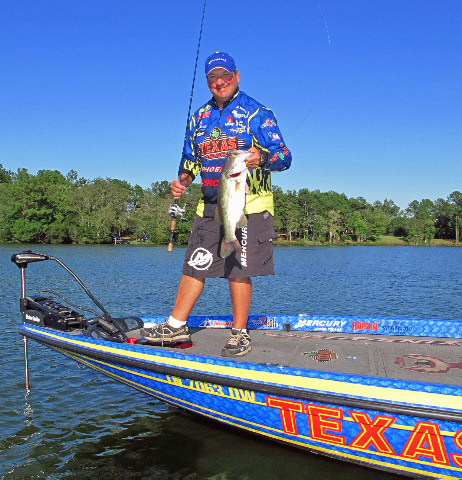
Texas Roadhouse pro Mike DelVisco has been mining the trophy bass fishery at V.I.P. Adventures for many years.
I was going to do a photo shoot of Mike for a story that Mike will be writing on this privately-managed trophy fishing destination that has been groomed and managed for premium guided bass fishing trips.
The six lakes at V.I.P. Adventures are reclaimed sand pits that had ceased mining operations about thirty years ago and are hydrated by numerous underground springs and water flowing in from surrounding wetlands. I mistakenly assumed they would be deep, quarry lakes with abrupt cliff-like drop-offs and very deep water. That was not the case as these sand-mined lakes proved quite shallow. I had been in constant contact with Texas Roadhouse pro Mike DelVisco about this trip and one simple question by me ("What's the water depth?") would have quickly clarified the shallow nature of the V.I.P. lakes. Yet I never thought to ask Mike about that. I had fished a few other reclaimed mining lakes in the past - all very deep. So it never occurred to me that a reclaimed mining operation could actually be so shallow. Most of the tree-lined shoreline was only a few feet deep. The many brushpiles strategically planted offshore ranged from a few to five or six feet deep. It was rare that we found more than six feet of water on these well cared for lakes. My mistake was packing a dozen spinnerbaits for the trip, the majority were heavy, deep-running Bassdozer spinnerbaits of 3/4 and 1 ounce which would have been ideal on deep pit mines, but were not appropriate for these shallow lakes. Fortunately, I had a pair of 1/2 oz plus 2 spinnerbaits that were 3/8 oz - and those were the ones which proved productive on this trip.
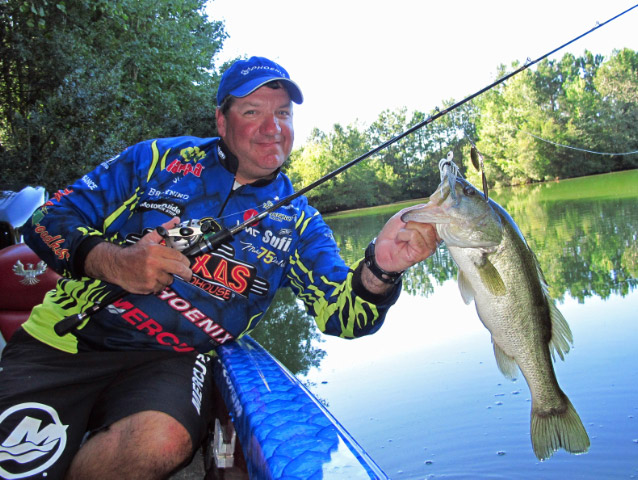
Although I did not have one with me this time, I recommend 1/4 oz Bassdozer spinnerbait for these lakes too - especially for Lake #4 which was the shallowest. The 3/8 oz was a little too heavy and ran a little too deep. The lighter 1/4 oz would have been a better choice for slow-rolling barely above the shallow bottom - or so I'd suggest without having one to actually try.
We fished Lake #4 our first day, and #4 was shallower than Lake #1 or #2, both of which we fished on our second day. We did not get time to try the other lakes (#3, #5 or #6) on this short trip that ended all too soon.
As I say, the 3/8 oz spinnerbait was a little too heavy and ran a tad too deep for Lake #4. The 3/8 oz spinnerbait dragged bottom on most casts and it tended to catch stringy black leaf detritus on the bottom that draped over the spinnerbait's nose every few casts. This was really only an inconvenience because I did not have the necessary 1/4 oz spinnerbaits on hand. The fish wanted a slow-roll as close to the bottom as possible. Many strikes occurred when I would bounce the spinnerbait over a sand bar or off the sloping edge of a flat. As soon as the spinnerbait transitioned over slightly deeper water (which could be sensed when the bait stopped tapping on top of the sand bar or flat), it often got hit at the exact moment it swung over the slope toward slightly deeper water. I would also recommend a streamlined bullet nose head shape (which I didn't have on hand) for Lake #4. The bullet nose spinnerbait head is cone-shaped like a Texas rig sinker. So it does not pick up any bottom debris like other head shapes do. Lakes #2 and #3 were slightly deeper than #4 and because of that, the 3/8 oz spinnerbait didn't rub its nose as hard on the bottom at #2 and #3. Still, it would have been interesting to see if the even slower roll of a 1/4 oz spinnerbait would have outproduced the 3/8. The bass did seem to want the spinnerbait the slower, the better.
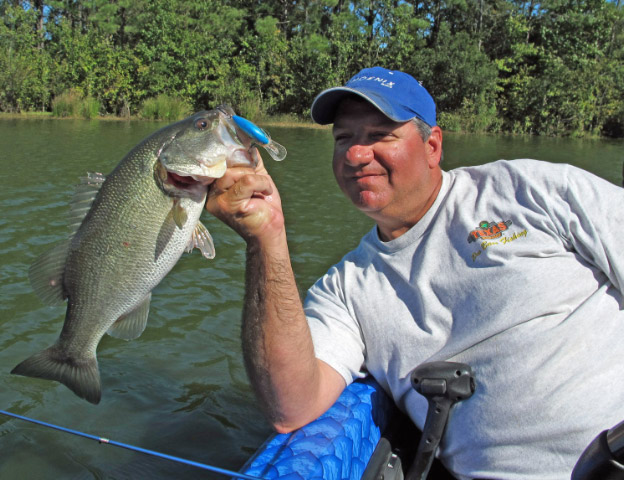
It sounds like I'm making excuses for not having that the "right stuff" - but that's not true. You see, I caught plenty of well-fed, hard-fighting bass on three of the spinnerbaits I had brought with me.
Just to digress for a moment, during the period when I was designing and developing many of my killer Bassdozer spinnerbait configurations, I caught from one to many good bass on spinnerbaits on every fishing trip on any body of water, almost every day, twelve months a year. For over three years straight, I caught bass on every trip with Bassdozer spinnerbaits. That's not to say Bassdozer spinnerbaits are always the best baits to use - but I do say that Bassdozer spinnerbaits will always catch at least one or more good fish, any day, any place and under any conditions for the skilled angler. That was the case on our V.I.P. Adventures trip too. A Bassdozer spinnerbait caught our biggest bass on each of the three lakes we fished there.
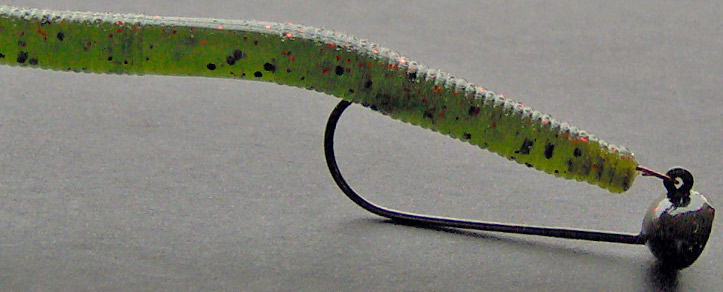
Bassdozer 1/2 oz Springfield Spinnerbait - Pro Sunfish. Our biggest bass on Lake #2 fell for this Pro Sunfish spinnerbait with metallic chartreuse blades. We did not get out at the absolute crack of dawn, but during the first few hours each morning, bass were out roaming open water looking for an easy meal. Roaming bass are great prospects for Bassdozer spinnerbaits because you can cover water quickly and opportunistic bass will not pass one up!
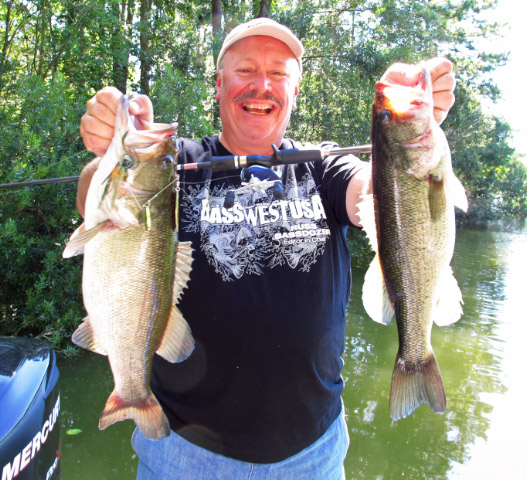
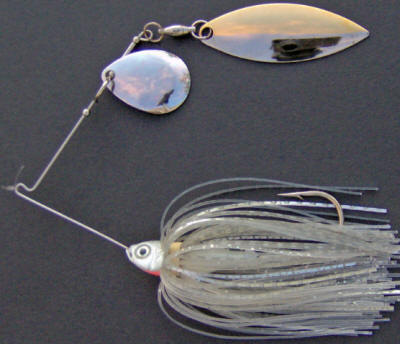
Bassdozer 3/8 oz Wisconsin Spinnerbait - Super Silver Shad. Our biggest bass at Lake #4 fell for this Super Silver Shad color of my Wisconsin style spinnerbait. Also our biggest bass on Lake #1 (our overall biggest bass for the trip) plus plenty of other good bass on Lake #1 fell for this Super Silver Shad Bassdozer spinnerbait. The small Colorado blade is genuine silver-plated (very rare to see on spinnerbaits) whereas the 50/50 Willow blade is half genuine gold-plated and half nickel-plated. This produces three different flashes from the blades: 1) a bright white silver flash, 2) a dark black nickel flash and 3) a brilliant gold flash. As if that wasn't enough, the silver hologram foil on the skirt reflects an even brighter flash than the blades.
There's no doubt the Super Silver Shad Bassdozer spinnerbait resembled a small pod of young-of-year shad which are the predominant forage at this time of the season (early October).
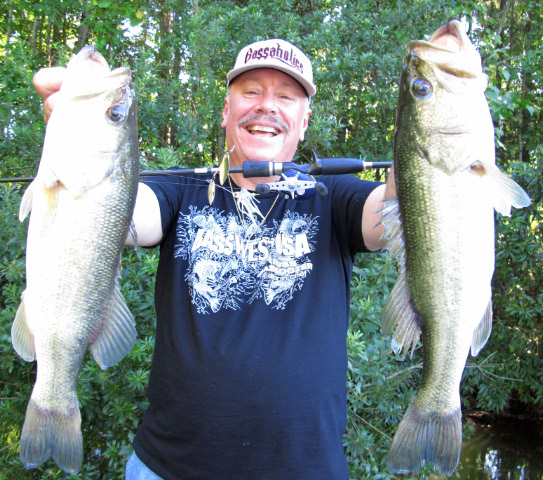
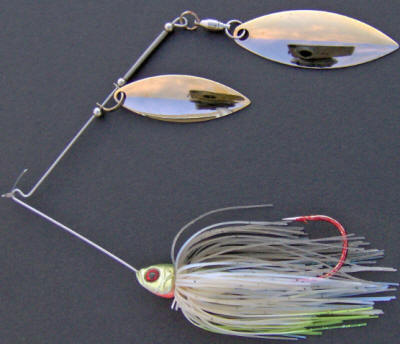
Bassdozer 3/8 oz Wisconsin Spinnerbait - Chartreuse Shad. Because the young-of-year shad were so plentiful and small at V.I.P. Adventures this time of year, I mainly relied on and did most of my catching with this downsized spinnerbait. I call these Wisconsin spinnerbaits because I designed them to look like, to be like and to be fished alongside my Wisconsin Swimming Jigs. It may be hard to gauge size in the photo, but everything about this spinnerbait is smaller than normal - except the hook and super wire. It has very small blades, a very small skirt and a hidden head. In comparison to a standard size spinnerbait, it looks more like a pod of very small shad. It has the 50/50 half gold and half nickel blades and as they spin, the flash of the two metals blink on and off like a vehicle's right turn signal. It's quite
attractive.
I am sure I could have caught even more fish...had I a few other suitable spinnerbait options with me - and especially if I had a few 1/4 oz models (which I did not). Unfortunately, 8 other spinnerbaits I packed were too heavy for the shallow lakes we fished here and for the particular conditions we faced on this trip.
As I say, the correct choice of Bassdozer spinnerbaits will always work but of course they aren't the only things that will catch fish. I had a bunch of feisty bass on some Bassdozer Springfield flipping jigs too.
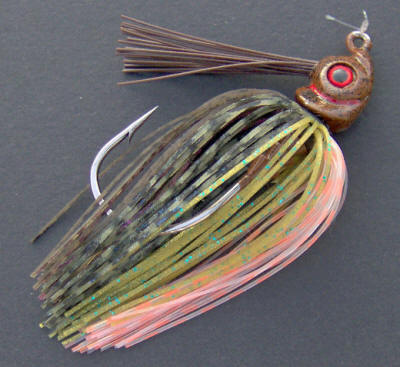
Bassdozer 1/2 oz Springfield Flipping Jig - Pro Bluegill. These flipping jigs are designed to a matching set with my Springfield model spinnerbaits. As we fished around the lakes, Mike and I found that a few bass were always willing to bite a jig flipped along the tree-lined shore and into the offshore brush piles. I used a Yamamoto 5" double tail grub in #301 color (green pumpkin with green and purple flake) as a trailer with both the Pro Bluegill and Brown Sunfish skirts.
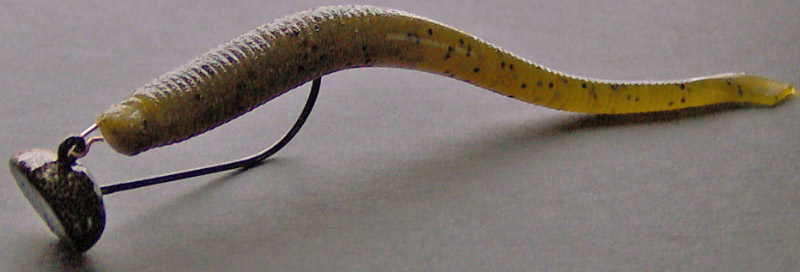
Bassdozer 1/2 oz Springfield Flipping Jig - Brown Sunfish. By luck, I happened to tie this particular jig on at the right time in the right place on Lake #2. As soon as I switched to it, Mike and I got into a 15-minute donnybrook with bass after bass after bass in a narrow, necked-down pass that connected two main basins of Lake #2 together. As you can see, I trimmed the skirt down because these are not massive lakes with deep water. Being small in size and relatively shallow, the lakes here are downsized ecosystems, and I've always found that jig skirts trimmed shorter than usual tend to work better and will "match the hatch" better on smaller bodies of water. That's not to say the fish aren't big at V.I.P. Adventures. They are, because it's strictly catch-and-release, the
big ones don't get kept and removed from these lakes like on other small waters.
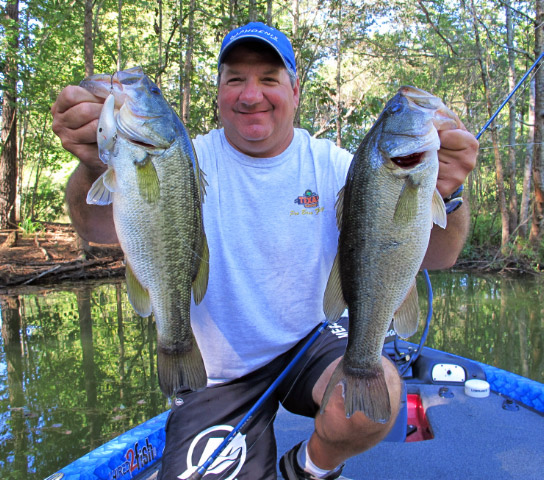
Mike DelVisco had some smoking hot flurries of action on a blue silver Rapala DT6 crankbait. Mike also did well flipping a Texas-rigged black Kinami Norie's Bug. Plus Mike used the Norie's Bug as a trailer on back of a mini-profile Keitech Tungsten black rubber jig. I know Mike tried a few other lures too, but the above-mentioned were his best producers this trip.
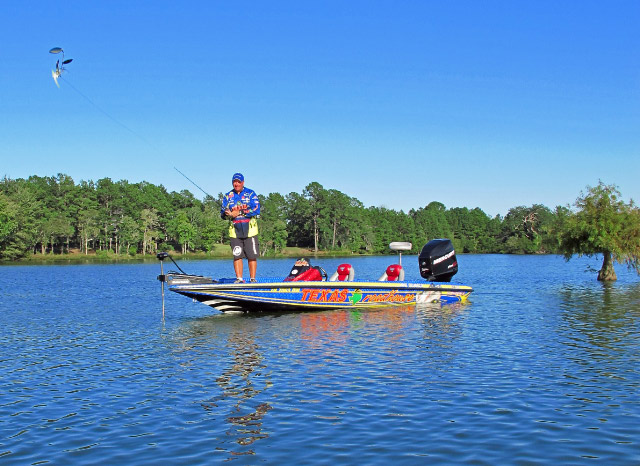
V.I.P. Adventures is the kind of place that you'll yearn to visit again and again. It is well-managed and a lot of fishing infrastructure has been added to the lakes by owner Mark Deschenes. Since Mike DelVisco is planning to write a story about this destination for BassWestUSA magazine, I won't say much more now except that the shoreline and underwater terrain is optimized for trophy bass fishing. One way to describe V.I.P. Adventures is that it's laid out like a world-class golf course for bass fishing, between the six lakes, each of which has unique topography and challenges.
I'd like to thank Mike DelVisco for inviting me there, and I am already dreaming of returning to fish on another great V.I.P. Adventure soon!

